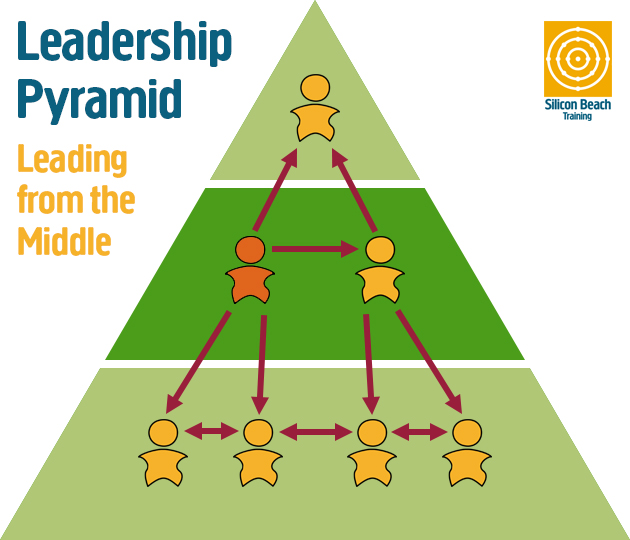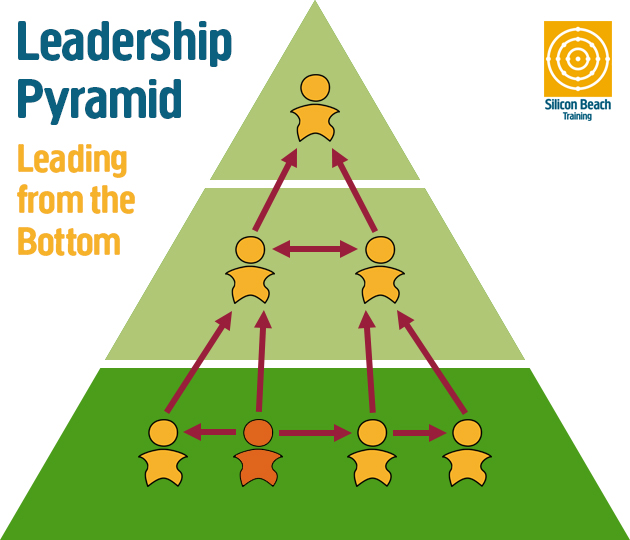Andy Trainer
16 Dec 2013
Why Leadership is Important at Every Level
"Who is your Leadership Skills course aimed at?"
That is the most common question we get asked about leadership training.
The answer?
Anybody who wants to lead in their organisation, from team members up to C-level executives and business owners.
It is a common misconception that leadership is only important for positions of authority.
I think that's wrong and in this post I'm going to explain why leadership is important at all levels of an organisation.
I've also put together some highly simplified graphics to show why I think that leadership at the bottom can often lead to highest level of organisational change.
Leading from the Top

In a recent Forbes post, leadership development expert Jack Zenger revealed research showing the impact that leadership style has throughout an organisation.
The study showed that the leadership style of top level 'alpha' leaders had a direct effect on the engagement levels of sub-ordinate 'beta' levels.
Most alarmingly, the study showed how bad leadership is contagious.
Alpha leaders with a bad leadership consumed more energy from the beta leaders who picked up their habits.
Luckily, good leadership is even more contagious than bad leadership.
The study showed the alpha leaders with a good leadership style had a stronger impact on beta leaders who in turn had a more positive impact on their direct reports.
This was the most interesting part of the report for me. You could guess that a bad leader at the top would have a negative effect and a good leader have a positive effect but the difference in impact on the organisation was clear.
It is essential to have the right leader at the top to let their positive leadership style filter down throughout the organisation.
It is also the role of the 'alpha' leader to nurture the top talent at their disposal. Without the right leadership you can risk losing your best employees to competitors.
To find out more about leading your top talent including why it's important and different types of leaders you will come across, read Jeswald W. Salacuse's article 'Leading Leaders: How to Manage the Top Talent in your Organization'.
Leading from the Middle

Top level management cannot be expected to inspire the whole organisation directly. In medium to large businesses many of the entry level employees rarely, if ever, meet anybody from the C-level.
Some more good news from the Zenger/Folkman study is that often the best 'beta' leaders are the ones with the worst bosses.
Rather than adopting the poor leadership style of their managers they act as a 'buffer' between the alpha leaders and their team members.
While this expends more of the middle leaders' energy, the act of protecting their team means that they better inspire their direct reports.
It's important for mid-level leaders to inspire their teams but they are also in a position to lead upwards; this is one of the most difficult skills to learn.
Tal Shnall describes four ways you can lead from the middle including tips to influence your managers and inspire your teams.
My favourite tip is to take responsibility. In a middle management position it can be easy to take direction from above and pass all responsibility downwards leaving you blameless if something goes wrong.
Taking that position can only last so long, eventually somebody is going to wonder what your value is. Be more than a facilitator or 'yes man' and prove your worth.
We've published some tips for leading upwards to try out in different situations.
Leading from the Bottom

As I mentioned at the start, the most common misconception about leadership is that you have to be in a position of authority to be a leader.
Yan Pritzker has written a great article about leading from the bottom based on Seth Godin's book Tribes and how Robert Scoble affected change at Microsoft by leading from the bottom.
The example Yan uses in the post demonstrates how the pyramid above works.
Early in his career, Seth was prevented from working on a particular project. Instead of moving on he worked on the project in his spare time.
He also started an internal newsletter which led to other people helping out in their spare time. The project carried on until management became aware of the power of the project and it became official.
Seth used the power of tribes to lead others at his level and lead upwards; which I've tried to demonstrate in the pyramid above.
Any of the employees in the bottom section can be the catalyst for change and influence others around and above them.
Often new or inexperienced team members have great ideas that senior management are not willing to try; leading from the bottom allows these ideas to come to fruition which can result in outcomes more senior team members had not thought of.
For tips on developing your leadership style as a non-manger read Kaan Turnali's article Leadership Starts with One or come down to Brighton for a leadership course!
Do you have experience leading in a non-management role? Let us know how you coped by leaving a comment below.
